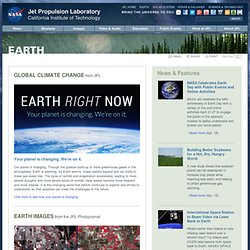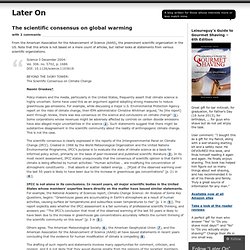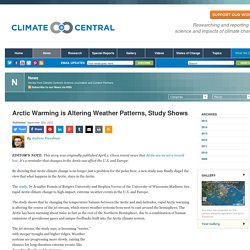

Climate Change: Vital Signs of the Planet. Earth. GLOBAL CLIMATE CHANGE from JPL Your planet is changing.

We're on it. Our planet is changing. Through the gradual build-up of more greenhouse gases in the atmosphere, Earth is warming. As Earth warms, ocean waters expand and ice melts to make sea levels rise. Click here to see how your planet is changing. EARTH IMAGES from the JPL Photojournal NASA Spacecraft Sees Stark Effects of California Drought on Agriculture Stark effects of a California drought on agriculture can be seen clearly in these two February images acquired by NASA's Landsat 8 in 2014 (left) and NASA's Terra spacecraft in 2003 (right).
Read more | | More Earth images Explore Earth satellites in 3D "Eyes on the Earth" is a 3-D visualization experience that lets users "fly along" with NASA's fleet of Earth science missions and observe climate data from a global perspective in an immersive, real-time environment. View interactive Earth Observing Missions CloudSat Revealing the inner secrets of clouds. › Mission home page.
Climate Change, Deforestation, Biomes and Ocean Currents, Plankton, Endangered Species - Earth Web Site. Click for more detail Thermohaline Change Evidence is growing that the thermohaline current may be slowed or stopped by cold fresh water inputs to the Arctic and North Atlantic oceans.

This could occur if global warming is sufficient to cause large scale melting of arctic sea ice and the Greenland ice sheet. Such a change in the current may be gradual (over centuries) or very rapid (over a few years). Either would cause planet wide changes in climate. This effect may be part of what starts and stops the ice ages. "Diatoms (a kind of phytoplankton) are estimated to "scrub" roughly as much CO2 from the atmosphere each year as all the world's rainforests.
"Net primary productivity is the mass of plant material produced each year on land and in the oceans by photosynthesis using energy from sunlight. Biodiversity is the variety of life found at all levels of biological organization, ranging from individuals and populations to species, communities and ecosystems. Click for more detail. The scientific consensus on global warming « Later On. From the American Association for the Advancement of Science (AAAS), the preeminent scientific organization in the US.

Note that this article is not based on a mere count of articles, but rather looks at statements from various scientific organizations. Science 3 December 2004: Vol. 306. no. 5702, p. 1686 DOI: 10.1126/science.1103618BEYOND THE IVORY TOWER: The Scientific Consensus on Climate ChangeNaomi Oreskes*Policy-makers and the media, particularly in the United States, frequently assert that climate science is highly uncertain. IPCC - Intergovernmental Panel on Climate Change. CLIMATE 101. Rachel Maddow: Skeptical scientist says climate change is real and caused by humans. Eh_podcast7. Arctic Warming is Altering Weather Patterns, Study Shows. EDITOR'S NOTE: This story was originally published April 3.

Given recent news that Arctic sea ice set a record low, it's a reminder that changes in the Arctic can affect the U.S. and Europe. By showing that Arctic climate change is no longer just a problem for the polar bear, a new study may finally dispel the view that what happens in the Arctic, stays in the Arctic. The study, by Jennifer Francis of Rutgers University and Stephen Vavrus of the University of Wisconsin-Madison, ties rapid Arctic climate change to high-impact, extreme weather events in the U.S. and Europe. The study shows that by changing the temperature balance between the Arctic and mid-latitudes, rapid Arctic warming is altering the course of the jet stream, which steers weather systems from west to east around the hemisphere. The jet stream, the study says, is becoming “wavier,” with steeper troughs and higher ridges. Global Warming Facts, Causes and Effects of Climate Change. Jump to Section Q: What is global warming? A: Here's a simple definition of global warming.
(And yes, it's really happening.) Over the past 50 years, the average global temperature has increased at the fastest rate in recorded history. And experts see the trend is accelerating: All but one of the 16 hottest years in NASA’s 134-year record have occurred since 2000. Climate change deniers have argued that there has been a “pause” or a “slowdown” in rising global temperatures, but several recent studies, including a 2015 paper published in the journal Science, have disproved this claim.
Q: What causes global warming? A: Global warming occurs when carbon dioxide (CO2) and other air pollutants and greenhouse gases collect in the atmosphere and absorb sunlight and solar radiation that have bounced off the earth’s surface. In the United States, the burning of fossil fuels to make electricity is the largest source of heat-trapping pollution, producing about two billion tons of CO2 every year.